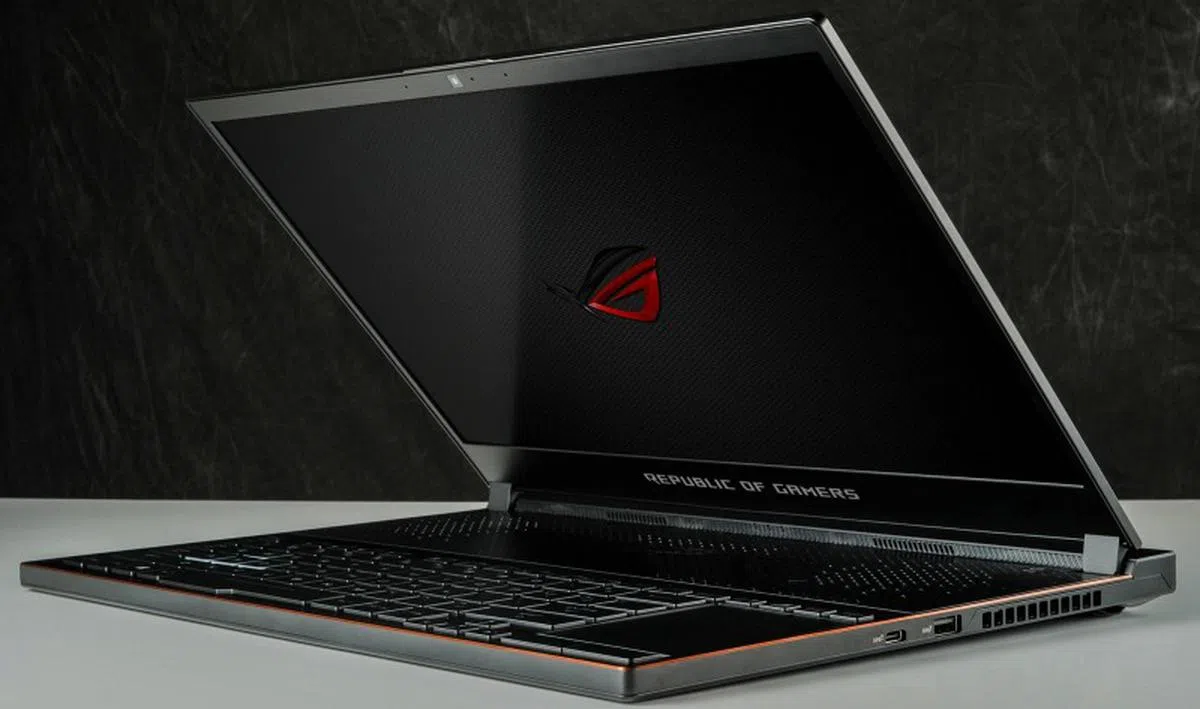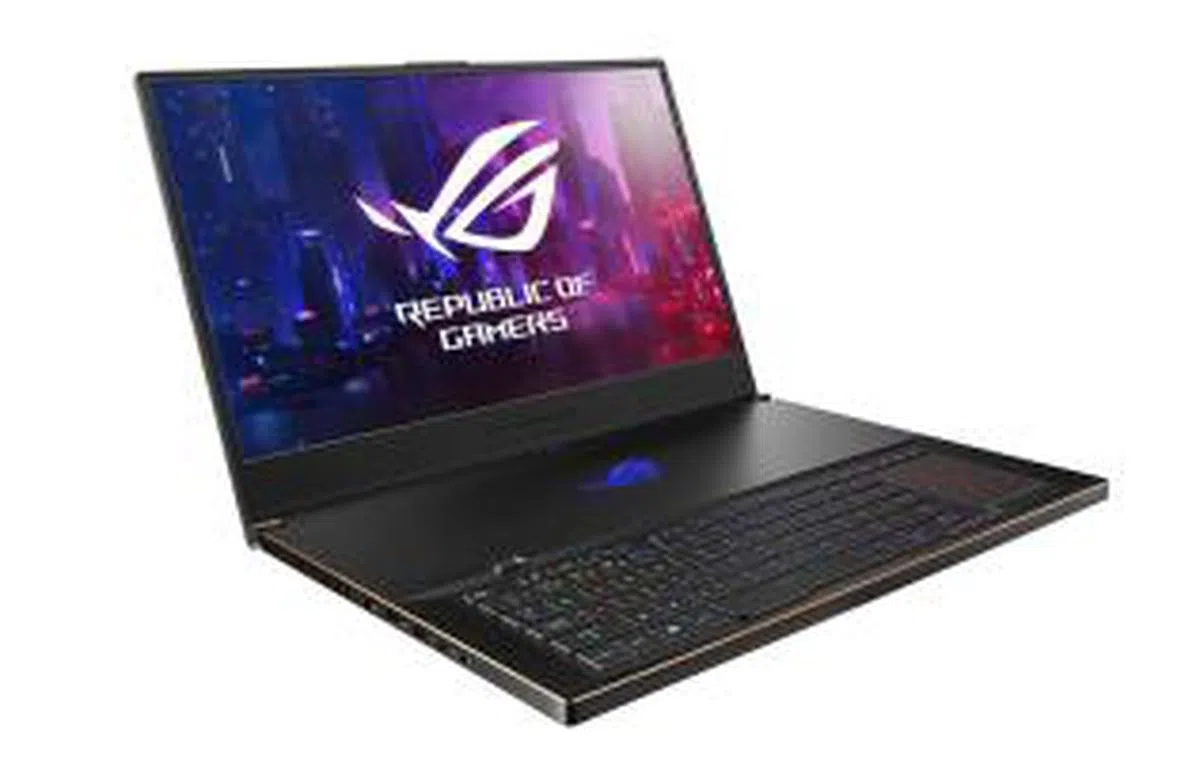ASUS ROG Zephyrus S GX531GX vs. GX701GX: Should you get a 15- or 17-inch notebook?
ASUS' Zephyrus S notebooks are available in both 15.6- and 17.3-inch variants. How do they compare against each other? We run the numbers for the verdict!
How does chassis size affect GPU performance?
ASUS' ROG Zephyrus series of laptops have come a long way. Since the launch of the ROG Zephyrus GX501 at Computex 2017, the Zephyrus series has evolved to include a far wider selection, including a more 'affordable' model like the Zephyrus M GM501 without Max-Q optimizations.
For 2019, ASUS has readied two updated Zephyrus S-series laptops featuring NVIDIA's new GeForce RTX GPUs. The ROG Zephyrus S GX531GX and GX701GX are 15.6- and 17.3-inch notebooks respectively, and they both come equipped with the flagship GeForce RTX 2080 Max-Q GPU. These represent the best of what the Zephyrus line-up has to offer, and they combine a slim and light design with class-leading gaming performance. Watch us unbox them!

Here's an overview of their specifications:
ROG Zephyrus S GX531GX
- 15.6-inch 1,920 x 1,080-pixel IPS 144Hz display
- Intel Core i7-8750H (2.2GHz, 9MB L3 cache)
- 24GB DDR4-2666 RAM
- NVIDIA GeForce RTX 2080 Max-Q
- 512GB PCIe M.2 SSD
- 60Wh battery
- 360 x 268 x 15.3-16.1mm
- 2.1kg
ROG Zephyrus S GX701GX
- 17.3-inch 1,920 x 1,080-pixel IPS 144Hz G-Sync display
- Intel Core i7-8750H (2.2GHz, 9MB L3 cache)
- 24GB DDR4-2666 RAM
- NVIDIA GeForce RTX 2080 Max-Q
- 1TB PCIe M.2 SSD
- 76Wh battery
- 399 x 272 x 18.7mm
- 2.7kg
The ROG Zephyrus S GX531GX costs S$4,498, while the larger GX701GX is more expensive at S$4,998. The ROG Zephyrus S GX701GX is also ASUS' first 17.3-inch notebook in the Zephyrus series, and it's one of the slimmest 17.3-inch laptops you can buy today.
Size aside, the two notebooks are very similar in many respects, but there are still small differences that could influence your decision to buy one or the other. I'll be taking a closer look at these differences in the next page. On top of that, another point to pay attention to is how the GeForce RTX 2080 Max-Q performs in a 15.6- and 17.3-inch laptop. Previous testing has shown that the performance of the GeForce RTX 2080 Max-Q can vary by quite a lot if the thermal design is not up to snuff, so the question now is whether it's worth paying more for the larger notebook and its presumably more powerful cooling solution.
Display

The ROG Zephyrus S GX531GX (left) beside the GX701GX.
The displays on both laptops are pretty good, featuring bright and vibrant colors and excellent viewing angles. According to ASUS, they've also been validated by Pantone and cover 100 per cent of the sRGB color space, which should signal more accurate colors. In practice, I have few complaints with either screen, and when set beside something like the Lenovo Legion Y740, it became quite apparent that the latter skewed toward the cooler end of the color spectrum.
Both laptops come equipped with a 1,920 x 1,080-pixel AHVA display and native 144Hz refresh rate, so gameplay should feel super smooth and fluid. In addition, ASUS is claiming a 3ms gray-to-gray response time for reduced motion blur. However, the 17.3-inch ROG Zephyrus S GX701GX has a leg up over its smaller sibling with support for NVIDIA's G-Sync variable refresh rate technology, which further eliminates tearing and stuttering.

The ROG Zephyrus S GX531GX still has space for a webcam in its top bezel.
That said, the benefits of G-Sync are most apparent at lower frame rates and refresh rates, such as a laptop with a 60Hz refresh rate and a less powerful GPU. Both Zephyrus S laptops are equipped with a GeForce RTX 2080 Max-Q, and the high refresh rate means that each frame stays on screen for a shorter time, so problems like tearing and stuttering become a lot less apparent. As a result, I don't think the inclusion of G-Sync on the GX701GX makes a super big difference in terms of gameplay.
Both laptops also feature super slim bezels on three sides, which helps reduce the overall footprint of the notebook. Unfortunately, they still have rather chunky bottom bezels, so they don't look quite as sleek as they could have been. However, if you look across the competition, there's no real leader in this design aspect, so ASUS has probably managed the best it could at this point of time.

The Zephyrus S GX701GX doesn't have an integrated webcam.
The GX701GX also diverges from the GX531GX when it comes to the webcam. While the latter crams a 720p webcam into the top bezel, which seems serviceable enough, the GX701GX doesn't have a built-in webcam at all. Instead, ASUS has opted to include an external webcam that can deliver 1080p video at 60fps. This webcam can be mounted onto the display or on its stand on your table, and it also allows for adjustments that can help you get the best angle.

The bundled webcam is a GC21 webcam that offers 1080p video at 60fps.
This is probably most useful for streamers for whom video quality is important, but I think folks who just make the occasional video call won't get much utility from it. Instead, they'll probably find it a hassle to have to plug in the webcam and mount it.
Design
Both laptops share the same design language, but the bigger GX701GX actually looks more similar to the original Zephyrus GX501 in some respects. For example, the GX531GX uses a new scissor-door hinge that allows the display to open up like a gull-wing door. However, the hinge on the GX701GX looks like the older one on the GX501. That said, the display appears to have a greater range of motion than on the GX531GX, although it wasn't by much.

The Zephyrus S GX531GX features a different hinge design from the GX701GX.
Either way, you won't be able to lay the lid anywhere close to flat on the Zephyrus S laptops, probably due to how the lid and the bottom panel work in tandem. To improve cooling, the bottom panel cracks open when the lid is raised, providing an additional outlet for air intake.

The bottom cracks open when the lid is raised.
The top intake vents on the ROG Zephyrus GX701GX also more closely resemble those on the GX501, taking the form of a pretty plain grid of dots. Conversely, the GX531GX adopts a new and more attractive design featuring diagonal slits.

The Zephyrus S GX701GX more closely resembles the original Zephyrus GX501.
Still, ASUS has paid a lot of attention to design here, and both laptops use a magnesium-alloy chassis that is both strong and light. The combination of brushed metal and matte surface finishes convey an impression of sophistication, and the diamond-cut edges have also been colored the company's signature "plasma copper". Build quality is solid, and there's barely any discernible flex to the body. However, the vents above the keyboard naturally mean that the area isn't as rigid as it could have been, but it's nothing I would worry about.

ASUS ROG Zephyrus S GX701GX has the same brushed metal finish on the lid as the GX531GX.
The keyboard on both notebooks are the same, offering the same 1.4mm key travel distance. The Windows Precision Touchpad also sits on the right, and you can toggle the digital number pad with the push of a button. I've always found this to be a pretty creative approach since you get the same layout and benefits of a full-sized keyboard while saving space. The trackpad is a bit narrow, but you're probably going to be using a mouse most of the time anyway.

The digital number pad is pretty awesome. Here's a look at it on the Zephyrus S GX701GX.
However, the ROG Zephyrus S GX701GX actually supports per-key RGB backlighting customizations, but the GX531GX is limited to just four independent zones. In addition, the backlighting on the GX701GX is noticeably brighter than that on the GX531GX, where it's barely perceptible under bright overhead lighting. Unfortunately, both notebooks exhibit uneven backlighting across some of the larger key legends, which can be a bit of an eyesore.

The keyboard backlighting on the Zephyrus S GX531GX could really use a brightness boost.
The speakers on the GX701GX are slightly better as well. The dual 2.5W speakers flank the keyboard and pump out surprisingly loud and full-bodied sound. I think gaming laptops have managed to include pretty decent speakers in recent years, but there are still many that sound thin, reedy, and shrill. Fortunately, the Zephyrus S isn't one of them, and lows and mids are pretty rich for a notebook.
In addition, there's a dedicated volume wheel above the left-hand side of the keyboard. I don't really find this a necessity, but it definitely is a convenient and pleasantly tactile way to make volume adjustments.

The volume wheel on the Zephyrus S GX701GX provides a really convenient way to adjust the volume.
On the other hand, the GX531GX features less powerful 2W stereo speakers and no volume wheel. They're also situated further back, sitting just below the display. The speakers aren't bad, but the mids did seem less lush and the overall sound was also more prone to distortion at higher volumes.
Cooling and power management

You can see here two of the exhaust vents at the rear of the Zephyrus S GX531GX.
The laptops use what ASUS' calls its Active Aerodynamic System (AAS) to stay cool. This comprises a ton of air intakes, dual high-speed 12V fans, five heat pipes, and an array of four heat sinks. The heat sinks are dedicated to the CPU and GPU and the circuitry that supplies them with power, and they're made up of ultra-thin copper fins that are as slim as 0.1mm. This means more fins and a larger surface area available for heat dissipation.
Cool air is drawn in through the large openings at the top and bottom (when the lid is open) and dumped out four vents at the sides and back. The vents on the side are also angled toward the back to direct warm air away from your mousing hand.
In addition, there's something of an anti-dust system in place in the form of tunnels that catch and redirect particles outside the chassis. This helps keep the heat sinks cleaner in the long run, something that's vital to cooling performance.
The more forward location of the keyboard also means that it's further away from the main heat generating components, so it feels cooler. However, the area above the keyboard can get quite hot to touch, especially around the center.

The keyboard, seen here on the Zephyrus S GX531GX, is located away from the main heat generating components.
Both laptops support NVIDIA's Optimus technology, which can automatically switch between the integrated and discrete graphics to conserve power, depending on the workload at hand. However, the GX701GX does have an additional control in the form of a so-called GPU switch. This is basically an option that lets you switch between G-Sync and Optimus modes. In the former, G-Sync is on, so the discrete GPU is active always. Conversely, if you want the automatic switching between integrated and discrete graphics, you'll need to manually enable Optimus mode.
Ports and connectors
The port layout is varies slightly between the two laptops. For starters, the ROG Zephyrus S GX531GX makes use of the sides and back, whereas the GX701GX restricts itself to just the left and right edges.
The smaller 15.6-inch model features one USB 3.1 (Gen 2) Type-C, one USB 3.1 (Gen 1) Type-C, one USB 3.1 (Gen 2) Type-A, and two USB 2.0 ports. The HDMI 2.0b port is located at the back, which may make cable management easier when outputting to an external display.

A look at the ports on the left of the Zephyrus S GX531GX.
The USB-C port on the right also supports output over DisplayPort 1.2, and you can charge the notebook via USB Power Delivery if you have a compatible power bank or Type-C power adapter. This is pretty useful if you forget the power brick or want to deal with something more compact.

The USB-C port on the right of the Zephyrus S GX531GX supports output over DP 1.2.
Like the GX531GX, the GX701GX has six USB ports as well, but the two USB 2.0 ports have been replaced by faster USB 3.1 (Gen 1) Type-A ports instead. The USB 3.1 (Gen 2) Type-C connector also supports the DisplayPort 1.4 standard instead of 1.2, and charging over Power Delivery will work as well with a 65W adapter.

The HDMI port on the Zephyrus S GX701GX is located on the left side, instead of the back.

There are two more USB 3.1 (Gen 1) ports on the right of the Zephyrus S GX701GX.
Test setup and performance
Here's a full list of the notebooks I tested:
- ASUS ROG Zephyrus S GX531GX
- ASUS ROG Zephyrus S GX701GX
- ASUS ROG Zephyrus S GX531GW
- Razer Blade
- Gigabyte Aero 15Y v9
I've included the ROG Zephyrus S GX531GW, which comes equipped with a GeForce RTX 2070 Max-Q, to show how much faster the GeForce RTX 2080 Max-Q models are. In addition, the Razer Blade and Gigabyte Aero 15Y v9 were thrown in as well to provide a reference point for other GeForce RTX 2080 Max-Q notebooks.
[hwzcompare]
[products=662752,662756,660213,661877,657507]
[width=200]
[caption=Test notebooks compared]
[showprices=1]
[/hwzcompare]
I ran the notebooks through the following benchmarks:
- PCMark 10
- PCMark 8
- 3DMark
- VRMark
- Deus Ex: Mankind Divided
- Tom Clancy's The Division
How good are they in daily computing tasks?
The ROG Zephyrus S GX701GX came ahead in PCMark 10 Extended, largely on the back of its strong performance in the Gaming and Digital Content Creation benchmarks. The smaller Zephyrus S GX531GX wasn't that far behind though, and there was just a 3 per cent differential between the 15.6- and 17.3-inch notebooks.
In PCMark 8's Storage benchmark however, the QLC NAND SSDs in the Zephyrus S GX531 models couldn't really keep up in terms of storage bandwidth.




How about games?
Gaming performance was excellent for both the Zephyrus S GX531GX and GX701GX. However, I should point out that not all GeForce RTX 2080 Max-Qs are configured the same. Even though they both supposedly have the same card, the GeForce RTX 2080 Max-Q in the smaller Zephyrus S GX531GX is clocked lower, featuring a 835MHz base clock and 1,195MHz boost clock. In comparison, the GX701GX has a 990MHz base clock and 1,230MHz boost clock.
A third notebook, the Razer Blade, also has a GeForce RTX 2080 Max-Q, but it's clocked at an 885MHz base clock and 1,185MHz boost clock.
These aren't super huge differences in clock speeds, but together with differences in cooling potential, they're enough to account for the performance differences you might see in various GeForce RTX 2080 Max-Q laptops.
In the case of the Zephyrus S GX531GX and GX701GX, they're pretty evenly matched, but it's clear that the 17.3-inch laptop has a small edge over its smaller sibling. In Deus Ex: Mankind Divided, the gap was as large as 8 per cent at 1080p and High settings.





How is the battery life?
Battery life was sort of a mixed bag here. The Zephyrus S GX531GX did pretty well, despite its relatively small 60Wh battery. It still isn't as good as the Razer Blade or Gigabyte Aero 15Y, but the latter two had much larger battery packs. In fact, a look at the power consumption figures show the GX531GX to be the more efficient laptop. Still, I'd really have liked to see ASUS cram a larger battery in here.
On the other hand, the GX701GX didn't even make it to the two-hour mark, and it had the highest power consumption of the lot. It even had a larger 76Wh battery and very similar specifications to the GX531GX.
Part of the reason is probably the higher GPU clock speeds, and it could be that ASUS decided to prioritize performance over battery life for the larger 17.3-inch model. That said, there's just one quirk in our review unit I have to point out. I mentioned earlier that the GX701GX is supposed to have a GPU switch that lets you toggle between Optimus and G-Sync modes in the Armoury Crate software. Unfortunately, this option was nowhere to be found in our version of Armoury Crate, and I was also unable to get the software to update to the latest version.
This means that it's not clear which mode the laptop was running in, and if it so happens to be G-Sync mode, it's possible that battery life could improve once Optimus is enabled. I've already reached out to ASUS on this issue, and will update these benchmarks if it turns out that this is a bug on the software end.
When it came to the portability index, which aims to be an objective measure of how portable a notebook is after taking into account factors like dimensions, weight, and battery life, the Zephyrus S GX531GX turned out a decent result. However, it was still behind its competitors with larger batteries. The Zephyrus S GX701GX in its current state performed abysmally though, and you'll want to make sure you have the power brick with you all the time.



Does it run hot?
The ASUS ROG Zephyrus S' cooling solution isn't just for show, and it does a pretty good job of keeping the crucial components running cool while preserving the laptop's slim form factor. Surprisingly though, CPU temperatures on the larger Zephyrus S GX701GX were much higher than that on the GX531GX.
Compared to the GX531GX, the GX701GX was also a tad bit quieter, although both notebooks still can be considered quite noisy. It's definitely not the worst I've encountered though, and I'd consider these noise levels pretty par for the course.

Sometimes, size does matter

The ROG Zephyrus S GX701GX is quite a bit larger than the GX531GX.
I really like ASUS' Zephyrus S laptops. They're slim, light, and fast, but they also have one of the most innovative cooling solutions on the market right now. While the non-standard keyboard placement might give some of you pause, I actually think it's pretty easy to get used to. Furthermore, because the keyboard is located further way from the main heat-generating components, it's also better at staying cool.
In other words, the design feels thoughtful and smart, unlike something like the Acer Triton 700. The latter had an excellent mechanical keyboard located in a similar position, but it bizarrely integrated the trackpad into some glass window above the keyboard. Now, that's a design that's really hard to wrap your head around.
The obvious question now is probably whether the 15.6- or 17.3-inch model is better. The 17.3-inch model has some extra bells-and-whistles, such as the volume scroll wheel, better speakers, and the external webcam. It also has faster USB ports and brighter keyboard backlighting, if you care about that. Conversely, the 15.6-inch laptop is a portable beast that offers an incredible amount of performance in a sleek package. It does certainly seem like the more rounded offering, combining both performance and decent battery life.
Ultimately, the larger GX701GX is for those who prioritize performance over all else, while the GX531GX is for those who want a more balanced offering. They cost S$4,998 and S$4,498 respectively, so you're paying a S$500 price premium for the additional features and the slight performance boost on the GX701GX. If I had to pick one though, I'd go for the smaller model, since the performance differences aren't that significant. And if I want a larger screen, I can simply hook it up to an external monitor.



